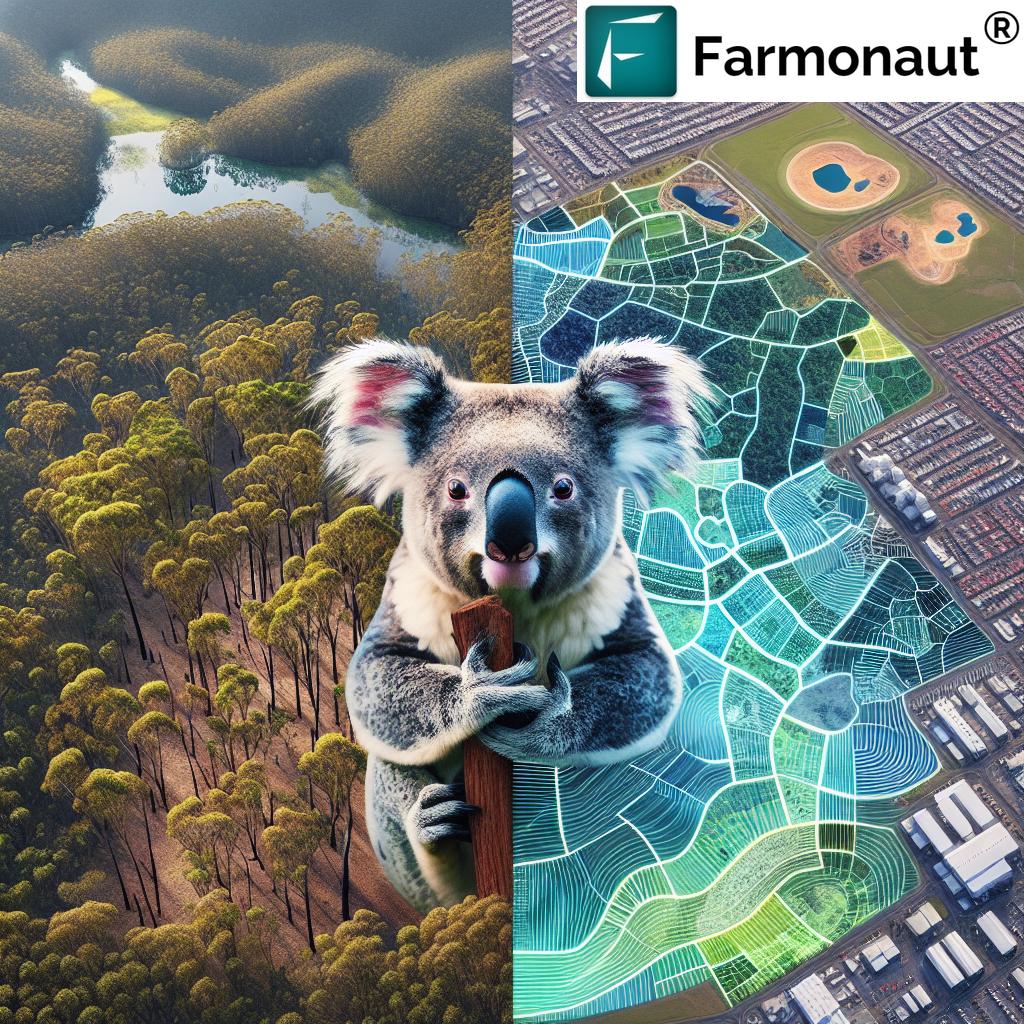Protecting Koala Habitats: Essential Guide to Queensland’s Conservation Regulations and Mapping
“South-East Queensland manages 716,000 hectares of regulated koala areas using advanced conservation technology and vegetation mapping.”
Welcome to our comprehensive guide on koala habitat conservation in South-East Queensland (SEQ). As experts in remote sensing and GIS technology, we at Farmonaut are deeply committed to supporting wildlife conservation efforts through innovative mapping and monitoring solutions. In this blog post, we’ll explore the intricate world of koala habitat protection, delving into the regulatory measures and cutting-edge mapping techniques that are crucial for safeguarding these vulnerable marsupials.

Koalas, iconic symbols of Australia’s unique biodiversity, face numerous challenges in their native habitats. The conservation of these adorable creatures is not just a matter of national pride but a critical environmental imperative. In this blog, we’ll uncover how 716,000 hectares of regulated koala areas in SEQ are managed through state-of-the-art wildlife conservation technology and vegetation mapping.
Understanding Koala Habitat Areas in South-East Queensland
To effectively protect koalas, it’s essential to understand the different types of designated areas within SEQ’s koala conservation framework. Let’s break down these crucial habitat designations:
- Koala Habitat Areas (KHA): These are core areas identified as essential for koala populations.
- Locally Refined Koala Habitat Areas (LRKHA): These are areas where local governments have conducted detailed assessments to refine habitat boundaries.
- Koala Priority Areas (KPA): These represent regions of strategic importance for koala conservation efforts.
Each of these designations plays a vital role in the overall strategy to protect and manage koala populations in SEQ. By understanding these areas, we can better appreciate the complexity of koala habitat conservation and the need for advanced mapping and monitoring technologies.
The Role of Technology in Koala Habitat Mapping
At Farmonaut, we recognize the power of technology in conservation efforts. While our primary focus is on agricultural applications, the same satellite-based monitoring and mapping technologies we use can be incredibly valuable for wildlife habitat management. Here’s how advanced technology is revolutionizing koala habitat conservation:
- Satellite Imagery: High-resolution satellite images provide a bird’s-eye view of vast koala habitats, allowing conservationists to monitor changes over time.
- GIS Mapping: Geographic Information Systems (GIS) enable the creation of detailed, layered maps that integrate various data sources for comprehensive habitat analysis.
- Remote Sensing: This technology helps in assessing vegetation health, a crucial factor in koala habitat quality.
While Farmonaut’s technology is tailored for agricultural applications, similar principles can be applied to wildlife conservation. Our expertise in satellite-based monitoring and GIS can provide valuable insights into habitat management strategies.
Regulatory Framework for Koala Habitat Protection
The Queensland government has implemented a robust regulatory framework to ensure the protection of koala habitats. This framework includes:
- Vegetation Management Act 1999: Regulates the clearing of native vegetation.
- Planning Act 2016: Governs development in koala habitat areas.
- Nature Conservation Act 1992: Provides for the conservation of nature, including koalas and their habitats.
These regulations work in tandem to create a comprehensive approach to koala habitat conservation. They set clear guidelines for land use, development, and vegetation management in areas crucial for koala survival.
Mapping Techniques for Koala Habitat Conservation
Effective koala habitat conservation relies heavily on accurate and up-to-date mapping. Here are some of the key mapping techniques used in SEQ:
- Vegetation Mapping: Detailed maps of vegetation types and densities help identify suitable koala habitats.
- Habitat Suitability Modeling: This involves analyzing various environmental factors to predict areas likely to support koala populations.
- Population Distribution Mapping: Tracking koala movements and populations helps in understanding habitat use patterns.
These mapping techniques, combined with advanced technologies like those used in Farmonaut’s agricultural solutions, provide a comprehensive picture of koala habitats and their changes over time.
Koala Habitat Areas (KHA): Core Conservation Zones
Koala Habitat Areas (KHA) form the backbone of SEQ’s koala conservation strategy. These areas are identified based on several criteria:
- Vegetation Composition: Presence of koala food trees and suitable forest structure.
- Historical Koala Presence: Records of koala sightings and populations.
- Habitat Connectivity: Areas that provide corridors for koala movement.
Within KHAs, strict regulations govern land use and development. These regulations aim to minimize habitat disturbance and maintain the ecological integrity of these crucial areas.
Locally Refined Koala Habitat Areas (LRKHA): Precision in Conservation
Locally Refined Koala Habitat Areas represent a more nuanced approach to habitat conservation. These areas are the result of detailed, local-level assessments that refine the boundaries of koala habitats. The process of creating LRKHAs involves:
- Local Ecological Surveys: On-the-ground assessments of vegetation and koala presence.
- Community Input: Incorporating local knowledge and observations.
- High-Resolution Mapping: Using advanced GIS and remote sensing techniques for precise boundary delineation.
LRKHAs allow for more targeted conservation efforts, taking into account local conditions and koala population dynamics.
Explore Farmonaut’s API for advanced mapping solutions
Koala Priority Areas (KPA): Strategic Conservation Focus
Koala Priority Areas are designated zones where conservation efforts are intensified due to their strategic importance. These areas are selected based on:
- Population Density: Regions with significant koala populations.
- Habitat Quality: Areas with optimal conditions for koala survival and breeding.
- Connectivity: Regions that link other important habitats, facilitating koala movement.
In KPAs, conservation measures are often more stringent, with greater restrictions on development and land-use changes.
“Queensland’s koala habitat protection system includes three key designations: Koala Habitat Areas, Locally Refined Koala Habitat Areas, and Koala Priority Areas.”
Vegetation Management in Koala Habitats
Effective vegetation management is crucial for maintaining healthy koala habitats. This involves:
- Protection of Koala Food Trees: Preserving and planting species like eucalyptus that are essential for koala diet.
- Habitat Restoration: Replanting degraded areas with native vegetation suitable for koalas.
- Corridor Maintenance: Ensuring connectivity between habitat patches to allow koala movement.
Vegetation management in koala habitats requires a delicate balance between conservation needs and human land use. It often involves collaboration between government agencies, landowners, and conservation groups.
Clearing Regulations and Exemptions in Koala Habitats
To protect koala habitats, strict regulations govern vegetation clearing in designated areas. However, certain exemptions exist to balance conservation with necessary human activities:
- Essential Infrastructure: Limited clearing for roads, power lines, and other critical infrastructure.
- Safety Measures: Clearing for fire breaks or to remove dangerous trees.
- Sustainable Agriculture: Carefully managed clearing for agricultural purposes in specific zones.
These exemptions are carefully regulated to ensure minimal impact on koala populations and their habitats.
Check out our API Developer Docs for integrating mapping solutions
Property Assessment Methods for Koala Habitat Conservation
Assessing properties for their koala habitat value is a critical part of the conservation process. This involves:
- Vegetation Surveys: Identifying koala food trees and habitat structures.
- Koala Activity Monitoring: Looking for signs of koala presence such as scratch marks and droppings.
- Habitat Connectivity Analysis: Evaluating how the property fits into the broader landscape of koala habitats.
These assessments help in determining the conservation value of a property and guide decisions on land use and management.
Habitat Restoration Techniques for Koala Conservation
Restoring degraded koala habitats is a crucial aspect of conservation efforts. Key techniques include:
- Native Tree Planting: Focusing on koala food trees and supportive vegetation.
- Weed Management: Removing invasive species that compete with native vegetation.
- Soil Rehabilitation: Improving soil quality to support healthy vegetation growth.
- Water Management: Ensuring adequate water resources for both vegetation and koalas.
Habitat restoration is a long-term process that requires ongoing monitoring and management to ensure success.

Biodiversity Management Strategies in Koala Habitats
Koala habitat conservation is part of a broader biodiversity management strategy. This holistic approach includes:
- Ecosystem Preservation: Protecting not just koalas but entire ecological communities.
- Invasive Species Control: Managing threats from non-native plants and animals.
- Wildlife Corridor Establishment: Creating and maintaining pathways for animal movement.
- Community Engagement: Involving local communities in conservation efforts.
These strategies ensure that koala conservation efforts contribute to overall ecosystem health and biodiversity.
Environmental Regulations for Endangered Species Protection
Koala conservation is part of a broader framework of environmental regulations aimed at protecting endangered species. Key aspects include:
- Habitat Protection Laws: Legislation specifically designed to safeguard critical habitats.
- Development Restrictions: Regulations limiting construction and land-use changes in sensitive areas.
- Wildlife Protection Acts: Laws prohibiting harm to koalas and other protected species.
- Environmental Impact Assessments: Mandatory evaluations of potential impacts on koala habitats for new projects.
These regulations form a comprehensive legal framework to ensure the long-term survival of koalas and other endangered species.
Sustainable Land Management Practices in Koala Habitats
Implementing sustainable land management practices is crucial for koala habitat conservation. These practices include:
- Rotational Grazing: Managing livestock to minimize impact on koala food trees.
- Agroforestry: Integrating tree cultivation with agricultural practices.
- Fire Management: Controlled burning to maintain habitat health and reduce wildfire risk.
- Water Resource Management: Ensuring sustainable water use that doesn’t negatively impact koala habitats.
These practices demonstrate how human land use can coexist with koala conservation efforts.
Wildlife Conservation Technology in Koala Habitat Management
Advanced technology plays a crucial role in modern koala conservation efforts. Some key technologies include:
- GPS Tracking: Monitoring koala movements and habitat use patterns.
- Drone Surveys: Conducting aerial assessments of habitat conditions and koala populations.
- Acoustic Monitoring: Using sound recordings to detect koala presence and activity.
- AI-Powered Image Recognition: Analyzing large datasets of wildlife camera images to identify koalas and assess population health.
These technologies provide valuable data for informed decision-making in koala habitat management.
Coordinated Efforts in Habitat Protection
Effective koala habitat conservation requires coordinated efforts from various stakeholders:
- Government Agencies: Implementing and enforcing conservation policies.
- Conservation Organizations: Conducting research and advocacy for koala protection.
- Landowners: Implementing habitat-friendly practices on private properties.
- Indigenous Communities: Incorporating traditional ecological knowledge into conservation strategies.
- Research Institutions: Providing scientific insights for evidence-based conservation.
This collaborative approach ensures a comprehensive and effective strategy for koala habitat protection.
Challenges and Future Directions in Koala Habitat Conservation
Despite significant efforts, koala habitat conservation faces ongoing challenges:
- Urban Expansion: Balancing development needs with habitat preservation.
- Climate Change: Adapting conservation strategies to changing environmental conditions.
- Disease Management: Addressing health issues affecting koala populations.
- Funding Constraints: Securing consistent financial support for long-term conservation projects.
Addressing these challenges requires innovative solutions, continued research, and sustained commitment from all stakeholders.
Comprehensive Table: Koala Habitat Conservation Areas in South-East Queensland
| Conservation Area Type | Description | Estimated Area (hectares) | Key Management Practices |
|---|---|---|---|
| Koala Habitat Areas (KHA) | Core areas essential for koala populations | Approximately 400,000 |
– Strict vegetation clearing regulations – Habitat restoration projects – Regular population monitoring |
| Locally Refined Koala Habitat Areas (LRKHA) | Areas with detailed local assessments | Approximately 200,000 |
– Tailored conservation strategies – Community-based monitoring programs – Localized development restrictions |
| Koala Priority Areas (KPA) | Regions of strategic importance for conservation | Approximately 116,000 |
– Intensified conservation efforts – Stricter development controls – Focused habitat connectivity projects |
Conclusion: The Path Forward for Koala Habitat Conservation
As we’ve explored throughout this guide, koala habitat conservation in South-East Queensland is a complex and multifaceted endeavor. It requires a delicate balance of regulatory measures, advanced mapping techniques, and collaborative efforts from various stakeholders. The use of innovative technologies, like those we develop at Farmonaut for agricultural applications, can significantly enhance our ability to monitor, protect, and restore crucial koala habitats.
While the challenges are significant, the commitment to preserving these iconic Australian marsupials and their habitats remains strong. By continuing to refine our approaches, leveraging cutting-edge technology, and fostering cooperation between government, conservation groups, and local communities, we can ensure a future where koalas thrive in their natural habitats.
As we move forward, it’s crucial to remember that koala conservation is not just about protecting a single species, but about preserving entire ecosystems and the biodiversity they support. The efforts we make today will shape the landscape of South-East Queensland for generations to come, ensuring that future Australians can continue to cherish these beloved animals in their natural habitats.
FAQs about Koala Habitat Conservation in South-East Queensland
- Q: What are the main threats to koala habitats in SEQ?
A: The main threats include urban development, habitat fragmentation, climate change, disease, and vehicle collisions. - Q: How can landowners contribute to koala habitat conservation?
A: Landowners can plant koala food trees, maintain wildlife corridors, and participate in local conservation programs. - Q: Are there any incentives for private landowners to protect koala habitats?
A: Yes, there are various incentive programs, including tax benefits and grants for habitat restoration projects. - Q: How often are koala habitat maps updated?
A: Habitat maps are typically reviewed and updated every few years, but the frequency can vary based on new data and resources. - Q: What role do citizen scientists play in koala conservation?
A: Citizen scientists contribute valuable data through koala sighting reports, participating in surveys, and assisting in habitat restoration projects.
By understanding and implementing these conservation strategies, we can all play a part in ensuring the survival of koalas in South-East Queensland. Remember, every effort counts in the preservation of these beloved Australian icons and their precious habitats.
















